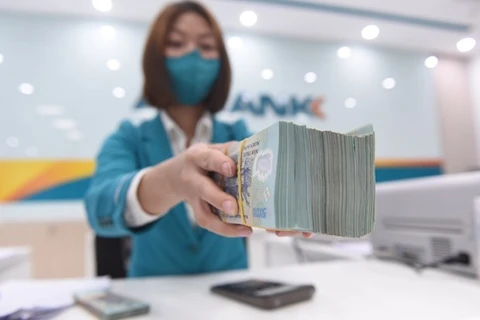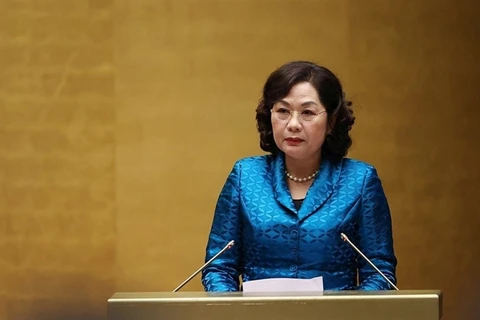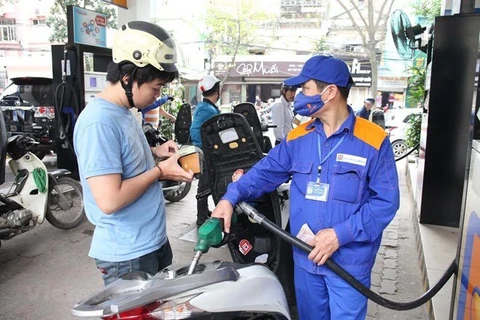Hanoi (VNS/VNA) - The National Assembly (NA) has agreed to extend a pilot resolution on bad debt settlement until the end of 2023 instead of this year.
The NA’s Resolution 42/2017/QH14 on piloting bad debt settlement of credit institutions, which was issued in 2017 and was set to expire on August 15 this year, will be applicable until December 31 next year.
Under the new resolution, the NA assigned the Government to study regulations on handling bad debt and collateral, and review to amend the Law on Credit Institutions to submit them to the NA before its meeting in May 2023.
During the extension of Resolution 42, the NA requires the Government to have solutions to overcome existing difficulties and problems besides directing competent ministries and agencies to work to ensure effective implementation of the resolution.
At the NA’s meeting last month, Governor of the State Bank of Vietnam Nguyen Thi Hong reported that after five years of implementing Resolution 42, the bad debt settlement of credit institutions has achieved positive results.
Accordingly, the bad debt ratio of credit institutions was controlled at below 2 percent. Compared with August 15, 2017 when the resolution started, total bad debts declined by 17.21 percent at the end of last year. From August 15, 2017 to November 30, 2021, 373.3 trillion VND (16 billion USD) of bad debt was recovered according to Resolution 42. On average, some 5.67 trillion VND of bad debts were handled each month during the application of Resolution 42, against about 2.14 trillion VND previously.
The Government, therefore, proposed extending Resolution 42 while it studies to legislate the policies specified in the resolution into a new law to continually enable the banking industry to settle bad debts of credit institutions. The issuance of a new law on bad debt handling will help credit institutions maintain and accelerate the handling of bad debts to avoid potential risks for the economy, Hong said.
Experts have also suggested streamlining Resolution 42 to better deal with bad debts.
According to banking expert Can Van Luc, one of the major problems when dealing with bad debts currently is the handling of collateral. The right to seize security assets of a credit institution is one of the key contents in Resolution 42, but it does not specify regulations when the borrowers do not cooperate. Therefore, Luc said it is necessary to have a law on bad debt settlement with a stronger legal framework.
Lawyer Truong Thanh Duc, Director of ANVI Law Firm, said Resolution 42 has a good effect in dealing with bad debts, however, the policy still needs to be further streamlined to improve the handling of bad debts in the banking industry./.
The NA’s Resolution 42/2017/QH14 on piloting bad debt settlement of credit institutions, which was issued in 2017 and was set to expire on August 15 this year, will be applicable until December 31 next year.
Under the new resolution, the NA assigned the Government to study regulations on handling bad debt and collateral, and review to amend the Law on Credit Institutions to submit them to the NA before its meeting in May 2023.
During the extension of Resolution 42, the NA requires the Government to have solutions to overcome existing difficulties and problems besides directing competent ministries and agencies to work to ensure effective implementation of the resolution.
At the NA’s meeting last month, Governor of the State Bank of Vietnam Nguyen Thi Hong reported that after five years of implementing Resolution 42, the bad debt settlement of credit institutions has achieved positive results.
Accordingly, the bad debt ratio of credit institutions was controlled at below 2 percent. Compared with August 15, 2017 when the resolution started, total bad debts declined by 17.21 percent at the end of last year. From August 15, 2017 to November 30, 2021, 373.3 trillion VND (16 billion USD) of bad debt was recovered according to Resolution 42. On average, some 5.67 trillion VND of bad debts were handled each month during the application of Resolution 42, against about 2.14 trillion VND previously.
The Government, therefore, proposed extending Resolution 42 while it studies to legislate the policies specified in the resolution into a new law to continually enable the banking industry to settle bad debts of credit institutions. The issuance of a new law on bad debt handling will help credit institutions maintain and accelerate the handling of bad debts to avoid potential risks for the economy, Hong said.
Experts have also suggested streamlining Resolution 42 to better deal with bad debts.
According to banking expert Can Van Luc, one of the major problems when dealing with bad debts currently is the handling of collateral. The right to seize security assets of a credit institution is one of the key contents in Resolution 42, but it does not specify regulations when the borrowers do not cooperate. Therefore, Luc said it is necessary to have a law on bad debt settlement with a stronger legal framework.
Lawyer Truong Thanh Duc, Director of ANVI Law Firm, said Resolution 42 has a good effect in dealing with bad debts, however, the policy still needs to be further streamlined to improve the handling of bad debts in the banking industry./.
VNA

























